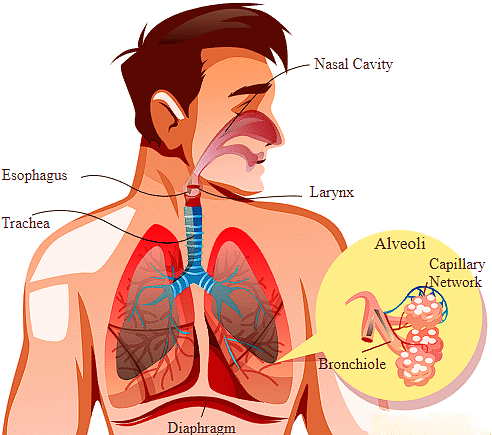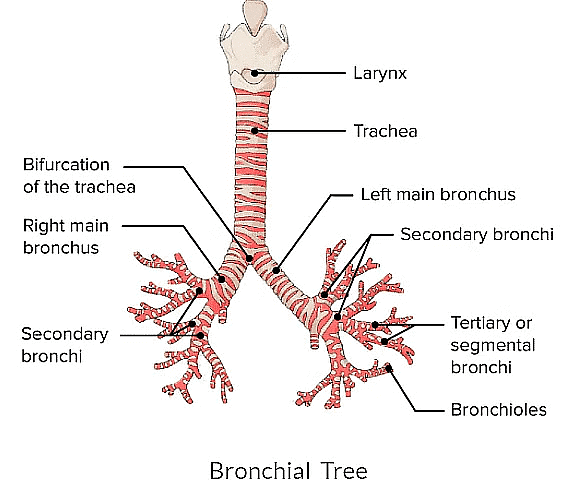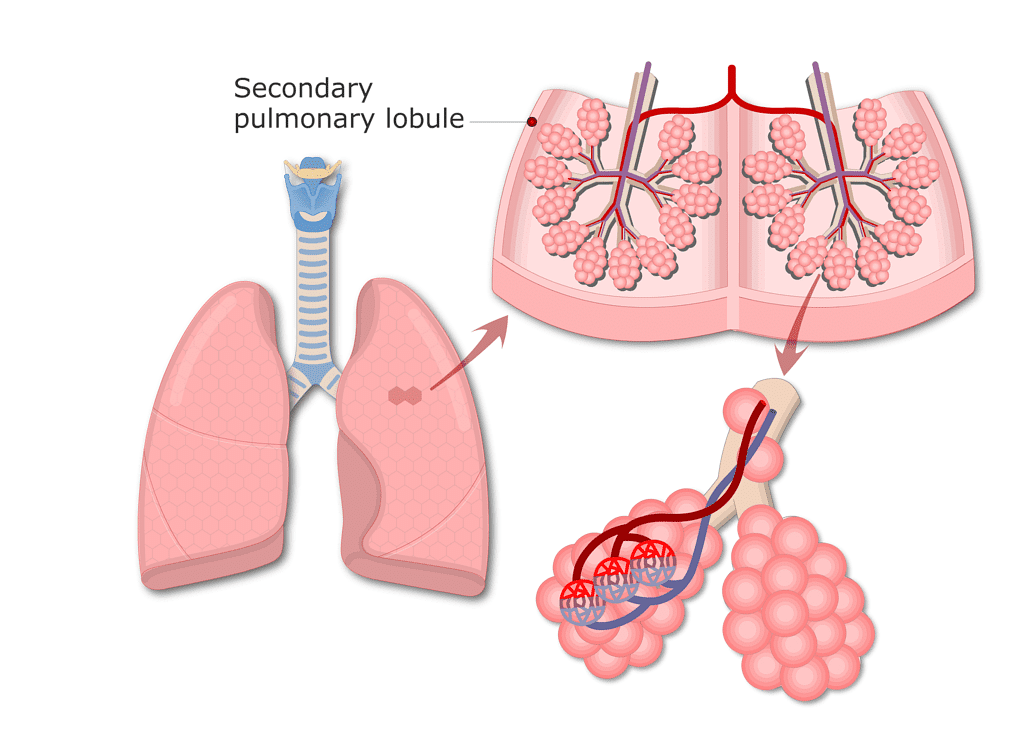Human Respiratory System | Biology Class 11 - NEET PDF Download
| Table of contents |

|
| What is Respiration? |

|
| Human Respiratory System |

|
| Parts of Human Respiratory system |

|
| Steps of Respiration |

|
| Process of Respiration |

|
Living organisms utilize oxygen (O2) to break down simple molecules such as glucose, amino acids, and fatty acids to obtain energy for various activities. In this process, carbon dioxide (CO2) is produced and released as a byproduct. To sustain this cycle, cells need a constant supply of oxygen while getting rid of carbon dioxide.
 Human Respiration
Human Respiration
What is Respiration?
The respiratory system takes up oxygen from the air we breathe and breathe out the unwanted carbon dioxide. The main organ of the respiratory system is the lungs. Other respiratory organs include the nose, the trachea and the breathing muscles
The mechanisms of breathing vary across different groups of animals, primarily depending on their habitats and levels of organization. In lower invertebrates such as sponges, coelenterates, and flatworms, oxygen and carbon dioxide are exchanged through simple diffusion across their entire body surface.
- Earthworms rely on their moist cuticle for gas exchange, while insects have a system of tubes called tracheal tubes that transport atmospheric air throughout their bodies.
- Aquatic arthropods and molluscs utilize special vascularized structures called gills for breathing, whereas terrestrial animals use lungs. Fish predominantly use gills for respiration, while amphibians, reptiles, birds, and mammals respire through lungs. Amphibians like frogs also have the ability to respire through their moist skin, known as cutaneous respiration.
Human Respiratory System
The human respiratory system is responsible for the exchange of oxygen and carbon dioxide between the body and the environment.

- It begins with the external nostrils, which open above the upper lips, leading air through the nasal passage into the nasal chamber.
- This chamber then connects to the pharynx, a shared pathway for both air and food. The pharynx directs the air into the larynx, or the voice box, which is a cartilage structure essential for sound production.
- The larynx features the glottis, which is protected by the epiglottis during swallowing to prevent food from entering the larynx.
Parts of Human Respiratory system
1. Nose
The nose serves as the entry point for air into the body, with the nostrils leading to the nasal passage.
2. Nasal Passage (Nasal Cavity)
Within the nasal passage, air undergoes filtration facilitated by fine hair and mucus secreted by mucosal glands, ensuring only clean air enters the lungs.
3. Pharynx
The pharynx, located between the nasal passage and the windpipe, serves as a conduit for air from the nasal passage to the trachea.
4. Trachea (Windpipe)
The trachea, supported by cartilage rings, allows air to pass from the nasal passage into the lungs without collapsing. It includes the larynx at its upper end, housing the voice box.
5. Bronchi
Descending from the trachea, the bronchi divide into smaller tubes connected to the lungs, facilitating the passage of air into each lung.

6. Lungs
Enclosed within the chest cavity and protected by the rib cage, the lungs play a vital role in respiration. Bronchi further divide into bronchioles, terminating in numerous alveoli, where gaseous exchange occurs.

7. Alveoli
These tiny air sacs facilitate the exchange of gases, with oxygen diffusing from the alveoli into the bloodstream and carbon dioxide diffusing from the bloodstream into the alveoli.
 Alveoli of lungs
Alveoli of lungs
8. Diaphragm
As a muscular partition separating the chest and abdominal cavities, the diaphragm aids in breathing by contracting during inhalation, expanding the chest cavity, and relaxing during exhalation, facilitating the release of carbon dioxide.
 Diaphragm
Diaphragm
Steps of Respiration
Respiration comprises several steps: Steps of Respiration
Steps of Respiration
- Pulmonary Ventilation: This is the process of breathing, where atmospheric air is inhaled, and carbon dioxide-rich air is exhaled.
- Diffusion Across Alveolar Membrane: Oxygen and carbon dioxide gases exchange across the alveoli's thin membrane.
- Transport of Gases: Blood transports these gases throughout the body.
- Diffusion Between Blood and Tissues: Gases diffuse between the blood and bodily tissues.
- Cellular Utilization: Cells use oxygen for energy-producing reactions, releasing carbon dioxide as a waste product.
Process of Respiration
1. The Pathway of Air
(a) Air moves from the larynx into the trachea, a straight tube that splits into the right and left primary bronchi at the 5th thoracic vertebra. These bronchi further divide into secondary and tertiary bronchi and then into smaller bronchioles, ending in terminal bronchioles.
(b) The trachea and bronchi are supported by cartilaginous rings, ensuring they remain open for air passage. Terminal bronchioles then lead to alveoli, which are small, vascularized structures where gas exchange occurs.
2. The Lungs and Pleura
(a) The lungs, composed of the bronchi, bronchioles, and alveoli, are essential organs of the respiratory system. They are encased in a double-layered pleura, with pleural fluid in between to reduce friction.
(b) The outer pleura adheres to the thoracic lining, while the inner layer is in contact with the lungs. This setup facilitates the lungs' expansion and contraction during breathing.
3. Functional Segments of the Respiratory System
(a) The respiratory system is divided into two main parts: the conducting part and the respiratory part. The conducting part, which includes structures from the external nostrils to the terminal bronchioles, transports air to the alveoli, filters it, humidifies it, and adjusts its temperature.
(b) The respiratory part, consisting of the alveoli and their ducts, is where the actual exchange of oxygen and carbon dioxide occurs.
4. The Thoracic Chamber and Breathing Mechanism
(a) The lungs are located in the thoracic chamber, bounded by the vertebral column, sternum, ribs, and diaphragm.
(b) Changes in the thoracic chamber's volume lead to lung expansion or contraction, facilitating breathing without directly altering lung volume. This anatomical arrangement is crucial for the process of respiration.
|
181 videos|360 docs|149 tests
|
FAQs on Human Respiratory System - Biology Class 11 - NEET
| 1. What is the main function of the human respiratory system? |  |
| 2. What are the parts of the human respiratory system? |  |
| 3. What are the steps involved in the process of respiration? |  |
| 4. How does respiration occur in the human body? |  |
| 5. Why is respiration essential for human survival? |  |

|
Explore Courses for NEET exam
|

|


















